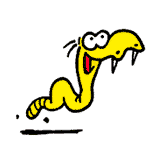
Wild Windellama
by Paul Alessi
March 2006
SSSSnake Season

A recent camping trip to the
Badga Mountains near Cooma was a good
reminder that we are well and truly in snake season, in five days
working
in tall Snow Tussock (Poa labillardierii) I had three run-ins
with Alpine
Copperheads (Austrelaps ramsayi) and on two of these occasions
came close to being bitten.
They are normally a slow and inquisitive snake
and this means they don't necessarily get out of your way until
your boot is almost on them and then they jump up and spring into
life. One of these Copperheads escaped across the TOPS of the
large
tussocks with a bizarre high speed wriggling action and I escaped
in the
opposite direction using some new found dance steps.
One of the things they say about
snake safety is not to walk in long
grass, very unfortunate for those that have to work in it.
Gum boots can be useful for protection but can be uncomfortable
if
you are wearing them for long periods on hot days.
Canvas gaitors are a better option, they are available from most
camping
shops and either of the above may save you from a bite on the
lower part of the leg.
At home a few days later I was
working in my green house tunnel
and picked up an armful of straw just missing the black snake
that was
hiding there by a few inches.
It's unlikely that we have any
Alpine Copperheads in Windellama
but we possibly have small numbers of the lowland species of
Copperhead ( Astrelaps superbus) in steeper country.
Commonly found in Windellama are
the much more excitable Eastern Brown Snake
(Pseudonaja textilis) in all parts of Windellama and Tiger Snakes
(Notechis scutatus),
usually inhabiting the open grasslands west of about Windellama
Hall but rarely in
Eastern Windellama. Red Bellied Black Snakes live here too of
course, are usually
close to water, and are less venomous and aggressive than the
above species.
The Brown Snakes here are not
brown at all but usually slender and grey, they have small heads
and can react very fast, even turning around completely to strike
back at something they
regard as a threat. I once saw The Crocodile Hunter Steve Irwin
handling an Eastern Brown
Snake on TV, he was very wary of it's willingness and ability to
strike without warning and
put it down quickly, Eastern Brown Snakes are the second most
venomous snake in the
world and given their cranky disposition regarded by many experts
as the most dangerous
snake in the world.
We've had both an Eastern Brown
Snake and a Red Belly Black Snake inside our home
and this is a very dangerous place to attempt snake handling or
dispatching. To avoid this
happening make sure your home is sealed up tight at all times,
gaps under doors
are the first point of entry though all gaps should be filled in,
tight fitting fly screens on
any door or window that are ever left open should be fitted and
even roof
eves might need to be sealed as snakes will follow the smell of
rats and mice, they are
excellent climbers, I once saw a brown snake hanging from a TV
antenna.
Maybe Charles Darwin could have
told us why Australia's venomous snakes evolved
with such a potent venom. Scientific tests have shown an Inland
Taipan has enough
to kill 218,000 mice, I'd like to see one eat that many, all up
that would be a meal
weighing more than 5 tonnes, probably to make humans feel safer
snake venom toxicity
is measured in mouse units.
All snakes should be left alone,
besides accidentally stepping on one, more people
are bitten trying to kill them than for any other reason.
Care should be taken at all times in all places, watch where you
are walking and use your
peripheral vision, snakes are where you find them and rarely
where you expect them.
..........................................
Thank you to Brent Brooke for
his help with this article, Brent is our local WIRES
animal rescue man and snake wrangler and he can be contacted on
02 48445470
And also a special thanks to
Sols (Allan Salisbury) for kindly lending us
Australia's most famous "Snake " for this Wild
Windellama.
...............................................
Copyright
Paul Alessi 2006